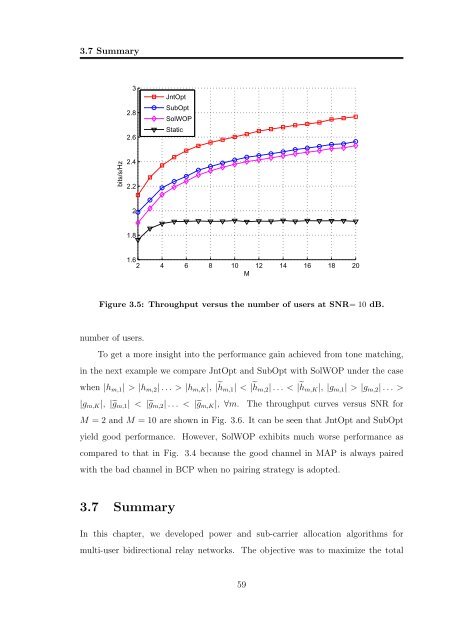Resource Allocation in OFDM Based Wireless Relay Networks ...
Resource Allocation in OFDM Based Wireless Relay Networks ...
Resource Allocation in OFDM Based Wireless Relay Networks ...
You also want an ePaper? Increase the reach of your titles
YUMPU automatically turns print PDFs into web optimized ePapers that Google loves.
3.7 Summary<br />
3<br />
2.8<br />
2.6<br />
JntOpt<br />
SubOpt<br />
SolWOP<br />
Static<br />
bits/s/Hz<br />
2.4<br />
2.2<br />
2<br />
1.8<br />
1.6<br />
2 4 6 8 10 12 14 16 18 20<br />
M<br />
Figure 3.5: Throughput versus the number of users at SNR= 10 dB.<br />
number of users.<br />
To get a more <strong>in</strong>sight <strong>in</strong>to the performance ga<strong>in</strong> achieved from tone match<strong>in</strong>g,<br />
<strong>in</strong> the next example we compare JntOpt and SubOpt with SolWOP under the case<br />
when |h m,1 | > |h m,2 | . . . > |h m,K |, |˜h m,1 | < |˜h m,2 | . . . < |˜h m,K |, |g m,1 | > |g m,2 | . . . ><br />
|g m,K |, |˜g m,1 | < |˜g m,2 | . . . < |˜g m,K |, ∀m. The throughput curves versus SNR for<br />
M = 2 and M = 10 are shown <strong>in</strong> Fig. 3.6. It can be seen that JntOpt and SubOpt<br />
yield good performance. However, SolWOP exhibits much worse performance as<br />
compared to that <strong>in</strong> Fig. 3.4 because the good channel <strong>in</strong> MAP is always paired<br />
with the bad channel <strong>in</strong> BCP when no pair<strong>in</strong>g strategy is adopted.<br />
3.7 Summary<br />
In this chapter, we developed power and sub-carrier allocation algorithms for<br />
multi-user bidirectional relay networks. The objective was to maximize the total<br />
59

















